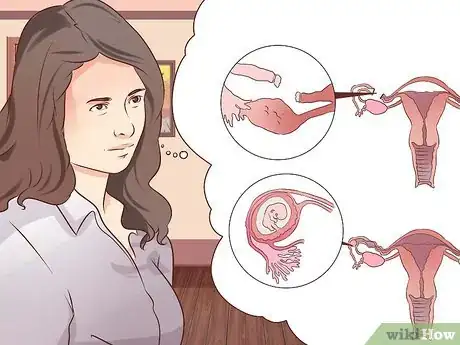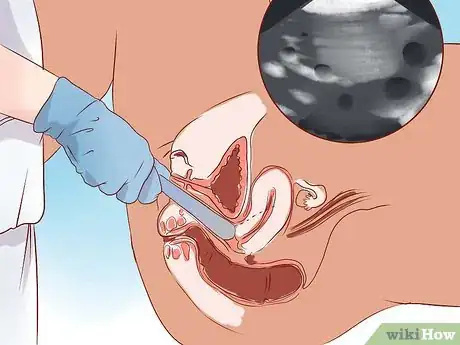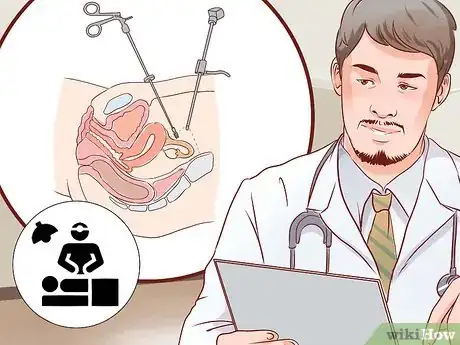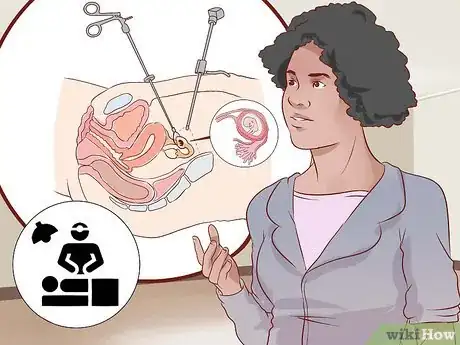This article was medically reviewed by Jonas DeMuro, MD. Dr. DeMuro is a board certified Pediatric Critical Care Surgeon in New York. He received his MD from Stony Brook University School of Medicine in 1996. He completed his fellowship in Surgical Critical Care at North Shore-Long Island Jewish Health System and was a previous American College of Surgeons (ACS) Fellow.
There are 22 references cited in this article, which can be found at the bottom of the page.
This article has been viewed 169,395 times.
Studies show that ectopic pregnancies, where the fertilized egg attaches to the fallopian tubes or an area outside the uterus, can turn into medical emergencies if left untreated. Ectopic pregnancies can be the results of a hormonal imbalance or abnormal development of the fertilized egg inside of your body. Experts note that it's important to know the symptoms of an ectopic pregnancy, as well as how to diagnose and treat this condition with the help of a doctor.[1]
Steps
Identifying the Symptoms of Ectopic Pregnancy
-
1Look for the absence of menstruation. If you have missed a menstrual period, and had unprotected sex prior to that, take a pregnancy test.[2]
- Although an ectopic pregnancy does not occur in the uterus, your body will present with many of the typical signs of pregnancy anyways.[3]
- If you have an ectopic pregnancy, the pregnancy test would hypothetically always be positive.[4] However, remember that these tests do have the possibility of false positive results or false negative tests, so if in doubt it is always a good idea to visit your doctor for a blood test for a confirmation.
-
2Start looking for other signs of pregnancy. If you are pregnant, whether it has implanted in the uterus (as in normal pregnancy) or in the fallopian tubes or elsewhere (as in ectopic pregnancy), you will still likely experience some if not many of these common symptoms:[5]Advertisement
-
3Feel for any abdominal pain. If you have already confirmed your pregnancy or you still aren’t sure, but you experience abdominal pain, then it could be because of an ectopic pregnancy.[8]
- The pain mainly occurs due to the pressure exerted by the growing fetus on the surrounding tissue, which in the case of an ectopic pregnancy does not have enough room to accommodate the fetus (the fallopian tubes for instance, the most common site of ectopic pregnancy, are not by any means designed to accommodate a growing baby).
- The abdominal pain can be sharp and severe, or in some cases there may be no pain.
- The pain often increases on movement and straining, and is often localized to one side of the abdomen.
- Shoulder pain can also present due to the presence of blood in the abdomen, which can irritate the nerve that travels up to your shoulder.
- Know, however, that round ligament pain is very common in pregnancy. This pain, similarly, is located on one side or the other (or both) and can come in intervals (which usually last a few seconds each). The main difference is that round ligament pain tends to occur in the second trimester. The pain from an ectopic pregnancy will usually emerge sooner than that.[9]
-
4Be aware of any vaginal bleeding. Light bleeding may occur due to irritation of the fallopian tubes as they are being stretched, and more profuse and severe bleeding may occur later as the baby grows to the point where the fallopian tubes may actually rupture. Bleeding during any sort of pregnancy is something that warrants examination from your doctor - particularly if it is continual or severe bleeding, in which case you are best to be seen in the emergency department sooner rather than later.[10]
- Severe bleeding from ruptured fallopian tubes (which can occur as a result of an ectopic pregnancy) can lead to significant blood loss, fainting, and in very rare instances death if not treated promptly by a medical professional.[11]
- Other serious symptoms (apart and aside from bleeding) which warrant prompt medical attention include severe abdominal pain, lightheadedness, dizziness, sudden paleness, or mental confusion, all of which could indicate a ruptured ectopic pregnancy.[12]
- Note that something called "implantation bleeding" is entirely normal. This occurs one week prior to your first missed menstrual period (3 weeks after your last menstrual period) and is a pinkish/brownish discharge that should fill more than a few pads. Bleeding from an ectopic pregnancy usually occurs later than this, after the embryo has implanted and begun to grow in a space that cannot accommodate very much growth.
- However, if bleeding at any time is bright red in color, taking up several pads, and not improving within a day or so, it is important to seek prompt medical attention.
Diagnosing Ectopic Pregnancy
-
1Consider whether any of the risk factors for ectopic pregnancy apply to you. If you are experiencing any of the symptoms mentioned above, you also need to consider if you fall into the high risk group of ectopic pregnancies. Certain factors increase a woman’s likelihood of experiencing an ectopic pregnancy.
- Generally, women who have had an ectopic pregnancy in the past are more likely to experience such pregnancies in the future too.[13]
- Other risk factors include: pelvic infections (sexually transmitted infections), multiple sexual partners (as this increases the chance of unknown STI's), fallopian tube tumors or abnormalities, previous abdominal or pelvic surgery, having an IUD, endometriosis, or smoking.[14] [15]
- Also, if a woman has had "sterilization" (also known a "tubal ligation" surgery, when her "tubes are tied" in an effort to prevent future pregnancy), although this is normally very successful in preventing pregnancy if one were to become pregnant the risk of it being an ectopic pregnancy is notably higher.[16]
-
2Have your β-HCG levels checked in a blood test. This is the first step towards the diagnosis of an ectopic pregnancy.[17]
- β-HCG is a hormone that is secreted by the developing embryo and placenta, so it rises as the pregnancy progresses and is a more definitive (and reliable) form of pregnancy test.
- If the β-HCG level is above 1500 IU/L (often between 1500-2000 IU/L is suspicious), but no pregnancy is seen with ultrasound, doctors will worry about you having an ectopic pregnancy. This is because the β-HCG levels are normally higher in ectopic pregnancy than in normal intrauterine pregnancies, so it is certainly a cause for suspicion.[18]
- If an ectopic pregnancy is suspected due to your β-HCG levels, your doctor will follow this up with a transvaginal ultrasound to see if she can visualize a pregnancy, and its location.[19]
-
3Undergo a transvaginal ultrasound. These ultrasounds can detect 75-85% of ectopic pregnancies (the growing fetus will be able to be seen on ultrasound in that percentage of cases, which confirms its location).[20]
- Note that a negative ultrasound does not rule out an ectopic pregnancy. A positive ultrasound (one that confirms the presence of a pregnancy in the fallopian tubes or elsewhere outside the uterus), however, is enough to make the diagnosis.[21]
- If the ultrasound is negative (i.e. inconclusive), but the β-HCG level is high and your symptoms are enough to concern your doctor that you may have an ectopic pregnancy, your doctor will likely recommend a "diagnostic laparoscopy," which is a simple surgery with very small incisions where they can insert cameras into your abdomen to have a clearer look.[22]
-
4Allow your doctor to perform a diagnostic laparoscopy. If your blood tests and ultrasounds seem inconclusive, and an ectopic pregnancy is still suspected, your doctor may perform a diagnostic laparoscopy to visualize your pelvic and abdominal organs internally to look for the spot of implantation.
- This procedure usually lasts for 30 minutes to an hour.
Treating Ectopic Pregnancy
-
1Seek treatment promptly. Once the diagnosis of ectopic pregnancy is confirmed, your doctor will want to treat you very quickly. This is because the treatment for ectopic pregnancy is much simpler when done sooner rather than later. Also, it is impossible for an ectopic tubal pregnancy to "survive"; in other words, the fetus won't be able to live anyway, so removing the pregnancy sooner rather than later prevents complications (which, if left too long, may become life-threatening).[23]
-
2Take medication that will abort the pregnancy. The most commonly administer medication in this scenario is methotrexate. It is given via intramuscular injection, one or more times, depending upon how much is needed to successfully get rid of the ectopic pregnancy.[24]
- After the injection of methotrexate is given, you will receive repeat blood tests to check your β-HCG level. If it drops to near zero (undetectable in the blood test), the treatment will be deemed successful; if not, you will receive more methotrexate injections until this goal is reached, and if it still not attained you may need surgery.[25]
-
3Have surgery to remove the ectopic pregnancy. During surgery, your doctors may also repair or remove the damaged fallopian tube if needed. Indications for surgery include:[26]
- Severe blood loss requiring urgent treatment.
- Failure of methotrexate treatment.
References
- ↑ https://my.clevelandclinic.org/health/diseases/9687-ectopic-pregnancy
- ↑ https://kidshealth.org/en/parents/ectopic.html
- ↑ https://www.acog.org/womens-health/faqs/ectopic-pregnancy
- ↑ https://www.nhs.uk/conditions/ectopic-pregnancy/
- ↑ http://www.uptodate.com/contents/ectopic-tubal-pregnancy-beyond-the-basics
- ↑ https://www.ncbi.nlm.nih.gov/books/NBK539860/
- ↑ http://www.uptodate.com/contents/ectopic-tubal-pregnancy-beyond-the-basics
- ↑ http://www.uptodate.com/contents/ectopic-tubal-pregnancy-beyond-the-basics
- ↑ https://physiciansandmidwives.com/pain-in-pregnancy-whats-normal-and-what-isnt/
- ↑ https://www.pregnancybirthbaby.org.au/ectopic-pregnancy
- ↑ https://my.clevelandclinic.org/health/diseases/9687-ectopic-pregnancy
- ↑ https://www.nhs.uk/conditions/ectopic-pregnancy/symptoms/
- ↑ https://www.ectopicpregnancy.co.uk/for-patients/faqs/english/
- ↑ https://www.cdc.gov/std/chlamydia/stdfact-chlamydia.htm
- ↑ http://americanpregnancy.org/pregnancy-complications/ectopic-pregnancy/
- ↑ https://pubmed.ncbi.nlm.nih.gov/1941685/
- ↑ http://americanpregnancy.org/duringpregnancy/hcglevels.html
- ↑ https://www.aafp.org/pubs/afp/issues/2000/0215/p1080.html
- ↑ http://www.webmd.com/baby/tc/ectopic-pregnancy-exams-and-tests
- ↑ https://www.ncbi.nlm.nih.gov/pmc/articles/PMC5024893/
- ↑ https://www.ncbi.nlm.nih.gov/pmc/articles/PMC2270872/
- ↑ http://www.medscape.com/viewarticle/568726_4
- ↑ http://www.medscape.com/viewarticle/568726_4
- ↑ https://www.ncbi.nlm.nih.gov/pmc/articles/PMC3191676/
- ↑ https://emedicine.medscape.com/article/2041923-treatment
- ↑ https://www.nhs.uk/conditions/ectopic-pregnancy/treatment/
About This Article
An ectopic pregnancy can sound worrying, but if you detect it early and get treated, you'll be able to recover from it faster. An ectopic pregnancy is when a fertilized egg gets trapped in your fallopian tubes or anywhere other than your uterus. It'll generally show positive on a pregnancy test and you may start to experience regular pregnancy symptoms, like breast tenderness, frequent urination, nausea, and a lack of menstruation. However, you may have additional pain in one side of your abdomen and your shoulder. You may also experience light bleeding at any time of the month. If you experience any bleeding, severe abdominal pain, lightheadedness, or dizziness, visit your doctor as soon as possible. Often, this is nothing to worry about, but an ectopic pregnancy can potentially be dangerous if untreated. If you do have an ectopic pregnancy, your doctor will probably give you a scan to see what’s going on and give you medication to break down the fertilized egg. To learn when surgery is necessary and other tips from our Medical co-author, read on.








































































Medical Disclaimer
The content of this article is not intended to be a substitute for professional medical advice, examination, diagnosis, or treatment. You should always contact your doctor or other qualified healthcare professional before starting, changing, or stopping any kind of health treatment.
Read More...